Silver lured many coin collectors and investors because of the metal’s high value. And this is especially true for earlier-dated coins, like the 1947 Dime.
Currently, a 1947 dime in circulated condition is valued at $2.10 to $2.60, while Mint state grades can go from $4.75 to $7,500. Note that this may vary depending on the grade and the variety of the coin. So read on if you want to gain more knowledge of the 1947 Dime Value.
| 1947 Roosevelt Dime Value Chart | |||
| Mint Location | Mintage | Coin Series | Estimated Value |
|
Philadelphia |
121,520,000 |
1947 MS Dime | $2.10-$525 |
| 1947 MS FT Dime | $15-$2,100 | ||
|
Denver |
46,835,000 |
1947-D MS Dime | $2.10-$1,350 |
| 1947-D MS FT Dime | $25-$7,500 | ||
|
San Francisco |
34,840,000 |
1947-S MS Dime | $2.10-$1,750 |
| 1947-S MS FT Dime | $20-$1,500 | ||
| 1947-S MS PL Dime | $300 | ||
| 1947-S MS FTP Dime | $195 | ||
1947 Roosevelt Dime History

The 1947 Dime is part of the Roosevelt Dime Series that still runs in circulation up to the present year. It marks the second year of the new dime design since its inception in 1946.
The Roosevelt dime replaced the Mercury dime, as ordered by the Treasury to commemorate President Roosevelt after he died in 1945. His service during the Great Depression and World War II made him a fitting figure on the coin alongside other influential presidents struck on other denominations.
The Roosevelt Dime was designed by Chief Engraver John R. Sinnock. It took him several revisions before getting approval for the model. Alas—in January 1946, the US minted over 344 million Roosevelt dimes for circulation under the Philadelphia, Denver, and San Francisco Mint. However, it declined to roughly 203 million in 1947, making some varieties for this year less common.
1947 Dime Specification and Design Details
- Category: Roosevelt Dime (1946-Present)
- Face Value: Ten Cents
- Obverse-Reverse Designer: John R. Sinnock
- Metal Composition: 90% Silver, 10% Copper
- Weight: 2.50 grams
- Diameter: 17.90 millimeters
- Edge: Reeded
It’s been a tradition to source several outside artists to create new coin models. However, the Mint specifically gave the task to Sinnock despite the Commission’s request for another invitational competition.

His final design on the obverse side showcases the portrait of President Roosevelt facing to the left. The words LIBERTY and IN GOD WE TRUST occupy the left field. Then, at the truncation of the neck is the designer’s initials JS, followed by the mint year.

The reverse side features an upright torch flanked by olive and oak branches. At the bottom of the elements reads E PLURIBUS UNUM, which is spaced ungainly in a single line. UNITED STATES OF AMERICA and ONE DIME surround the center design, all while separated with an ornamental dot.
Meanwhile, those coins minted in Denver or San Francisco have a “D” or “S” mintmark at the bottom left side of the torch.
1947 Dime Varieties and Valuation
The 1947 dime has eight regular strike varieties, two of which don’t have a mintmark. In terms of production, Philadelphia minted the highest number of 1947-dated dimes, followed by Denver and San Francisco, minting 203,195,000 combined.
Now, let’s discuss each and see their current market value.
1947 P (No Mintmark) Dime Value
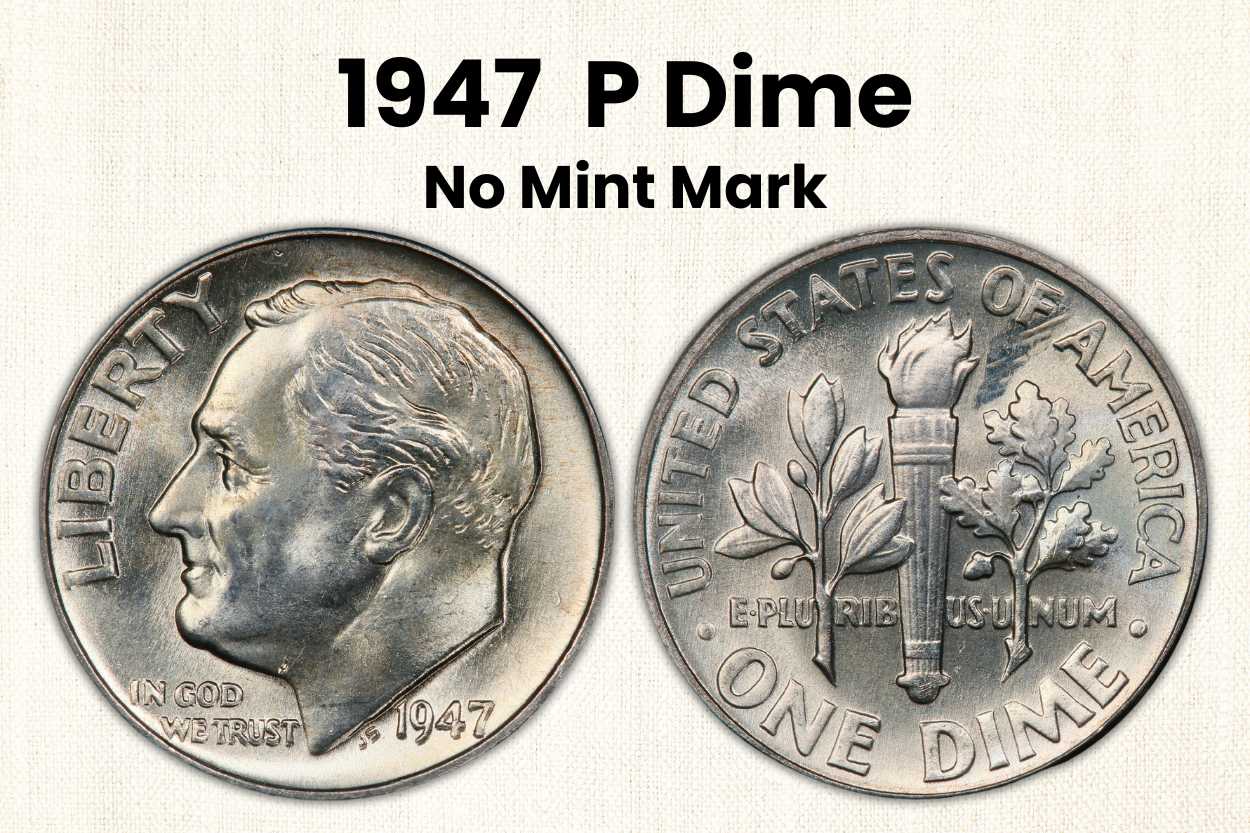
Despite the drop in production since inception, the 1947 Dime from Philadelphia is very common across all grades up to MS-66. Now you might be wondering, wouldn’t it decrease the coin value? To answer it, early edition coins, like the 1947 dime, have collector value albeit a high survival estimate.
Circulated condition 1947 dime sells for $2.10 to $2.60, which is higher than some varieties from the 1950s or 1960s dime issue.
But if you’re interested in obtaining an uncirculated grade, like MS-67 and above, you can expect it to sell for $4.75 to $525. Superb Gem condition samples are scarce, elevating their worth even more.
In terms of Full Torch (FT) samples, it is much scarcer because most 1947 dimes produced in Philadelphia have weak strikes. Coins with FT designation exhibit a full separation on the top and bottom bands of the torch. And as expected, FT dimes are in mint state condition to preserve the details.
A 1947 FT Dime in MS64 grade is valued at $15, while MS65 to MS-68 can range between $20 to $2,100.
| 1947 (P) Roosevelt Dime Value Chart | ||
| Coin Grade | 1947 10C | 1947 10C FT |
| Circulated
(G4-XF40) |
$2.10 | / |
| About Uncirculated (AU50-AU58) | $2.10-$2.60 | / |
| Uncirculated
(MS60-MS64) |
$4.75-$10 | $15 |
| Gem Uncirculated
(MS65 and above) |
$15-$525 | $20-$2,100 |
1947-D Dime Value
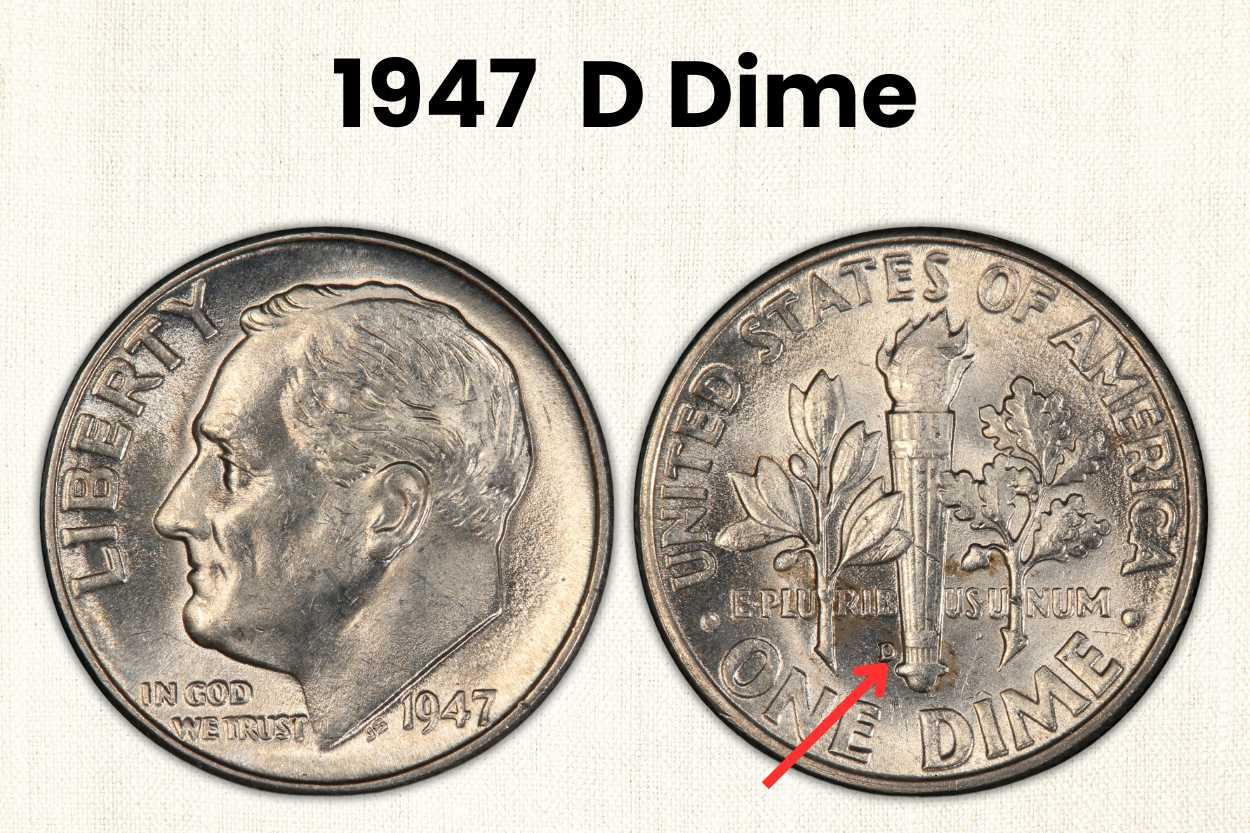
Unlike the 1947 (P) dime, most 1947-D were saved from circulation. Thus, Mint state condition samples are common. However, MS-60 and above still command a higher price than most common dates from the series.
A 1947-D circulated condition dime is valued likewise at $2.10 to $2.60, while an uncirculated condition sells higher for about $15 to $1,350. MS67 and above roughly have a hundred examples, causing it to market for thousands of dollars. An example is this 1947-D MS68 dime with a sale price of $1,840, sold by Heritage Auctions.
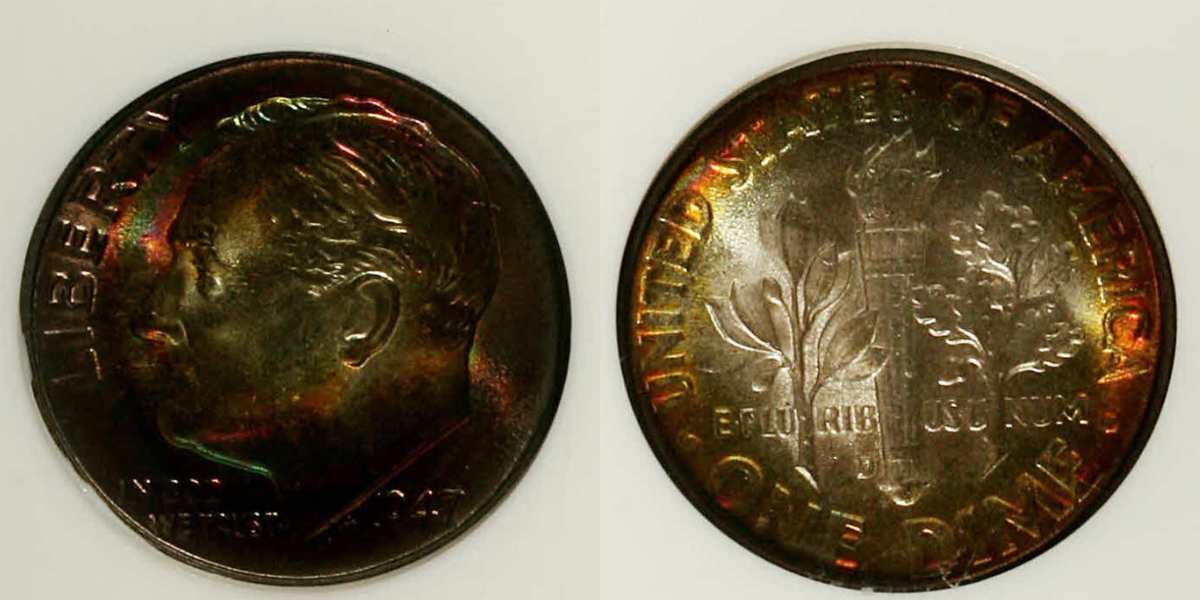
In terms of FT coins, the Denver Mint has superior strikes, making samples enough for advanced collectors. A hundred specimens were probably among the first strikes from a fresh die because as the production passed, the dies took its toll, limiting well-struck dimes.
Looking at its value, a 1947-D FT Dime in MS64 grade can sell for $25 to $27.50, while MS65 and above can reach $30 to $7,500.
| 1947-D Roosevelt Dime Value Chart | ||
| Coin Grade | 1947-D 10C | 1947-D 10C FT |
| Circulated
(G4-XF40) |
$2.10 | / |
| About Uncirculated (AU50-AU58) | $2.10-$2.60 | / |
| Uncirculated
(MS60-MS64) |
$4.75-$10 | $25-$27.50 |
| Gem Uncirculated
(MS65 and above) |
$15-$1,350 | $30-$7,500 |
1947-S Dime Value
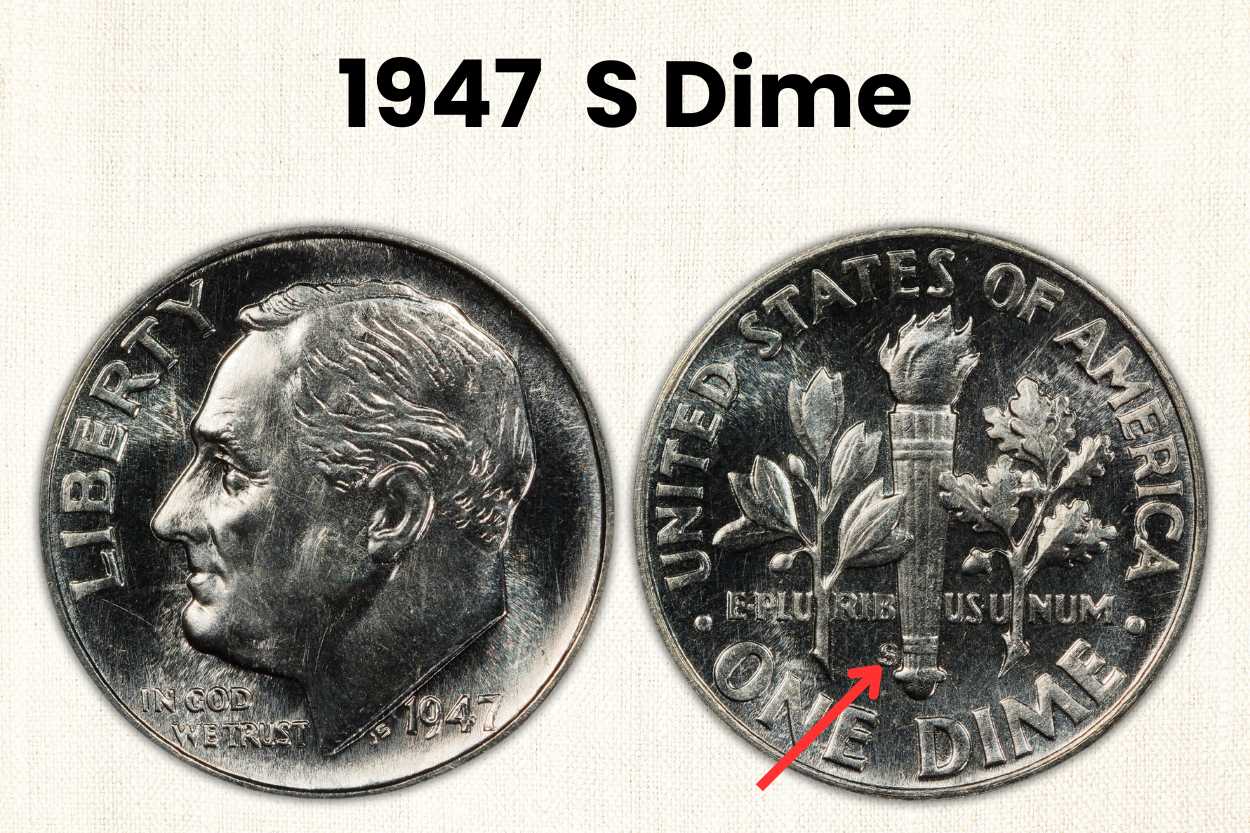
The San Francisco Mint has the lowest mintage of 1947 dimes out of the three Mints, with only 34,840,000 produced. But what makes it parallel with the D-marked coins is the bulk of the issue survived in Mint State condition. Although, MS67 specimens are scarce for this variety.
Like the previous varieties, a circulated condition 1947-S can sell for $2.10-$2.60, while an uncirculated condition can fetch $15 to $1,750, a few dollars higher than the no-mintmark 1947 dime.
FT samples, on the other hand, are hard to find since most coins are softly struck from heavily worn dies. With their values, an MS64 FT can sell at around $20, while MS65 and above are estimated at $25 to $1,500.
How about prooflike dimes? Are they more valuable than the average Mint state condition coins?
Mint workers usually repolish worn-out dies to remove the erosion lines. Doing this resulted in proof like coins that have shallow or partially erased features. But it’s still worth the money, as an MS67 PL can fetch $300, while an MS66 MS FT PL sits at $195.
| 1947-S Roosevelt Dime Value Chart | ||||
| Coin Grade | MS | MS FT | MS PL | MS FTPL |
| Circulated
(G4-XF40) |
$2.10 | / | / | / |
| About Uncirculated (AU50-AU58) | $2.10-$2.60 | / | / | / |
| Uncirculated
(MS60-MS64) |
$4.25-$10 | $20 | / | / |
| Gem Uncirculated
(MS65 and above) |
$15-$750 | $35-$1,500 | $300 | $195 |
1947 Roosevelt Dime Die Varieties
The 1947 dime has several die varieties popular among variety collectors. Among these are doubled die, over mintmark, and repunched mintmarks coins. In this section, we’ll tackle the samples that appeared in auctions to give you a gist of their value.
Doubled Die Obverse/Reverse (DDO/DDR)
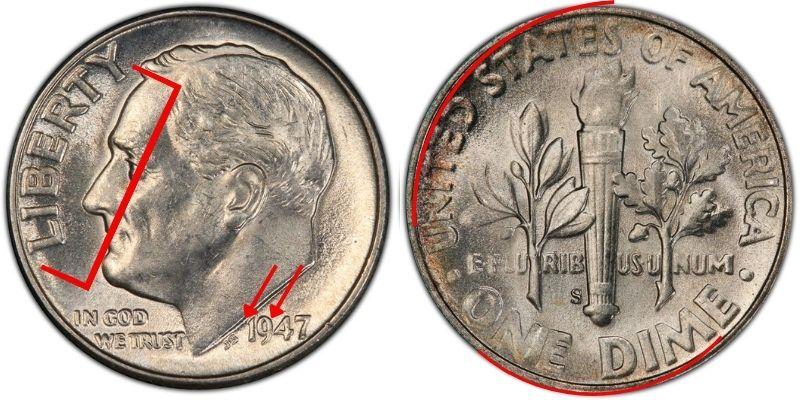
DDO and DDR are the most common die varieties in the 1947 dime issue. Doubled die features duplication of design elements either on the obverse or the reverse side due to misalignment of the die or hub.
For the 1947 Dime, the word LIBERTY and the digit 19 on the obverse usually have the most prominent doubling. Meanwhile, it is the words STATES OF AMERICA and ONE DIME for the reverse.
Now—looking at their auction record, two die DDO/DDR varieties sold for over a hundred dollars. These are the 1947 MS64 DDO, sold for $300, and the 1947-S MS67 DDR, sold for $330.
Over Mintmark (OMM)
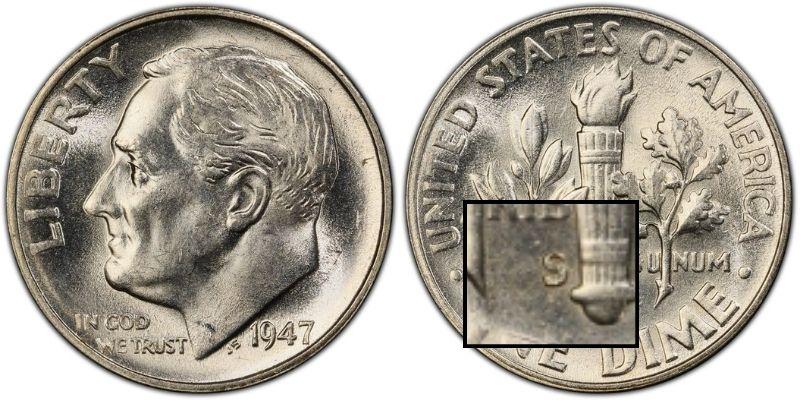
OMM is also under the category of doubled die. However, an OMM is more evident because two mintmarks overlap instead of one design. It happens when a second mintmark gets punched over an earlier mintmark.
But how would a San Francisco Mint have a Denver Mintmark die? It’s possible when one Mint transfer their die to another facility. For this year, an S over D coin is typical and can sell for a couple of dollars.
An example is the 1947-S/D MS67 OMM, which fetched $646.25, and an MS66 FB, which sold for $504.
Repunched Mintmark (RPM)
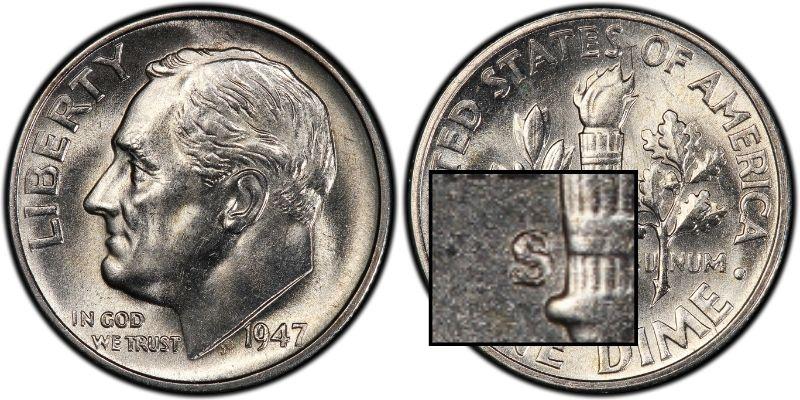
An RPM variety is like a doubled die, except it only affects the mintmark. It happens when the letter punch leaves two or more offset impressions on the new coin. Typically, they would overlap with one another. But situations where there is a complete separation are considered rare.
The highest sale price for this die variety reached a striking $989 for a 1947-S/S MS64.
1947 Dime Error Coins and Their Estimated Market Value
While die varieties are rife for the 1947 dime, only a few error coins are known for the series. However, this is not much of an issue because collectors opt for those with doubled die, over mintmark, and repunched mintmark. Also, there are no auction records for the 1947 dimes with dramatic Mint errors. But if you spot any from a coin shop, high chances are they only sell for more or less a hundred dollars. Here are some of them, including their estimated value.
1947 Dime Die Break Error
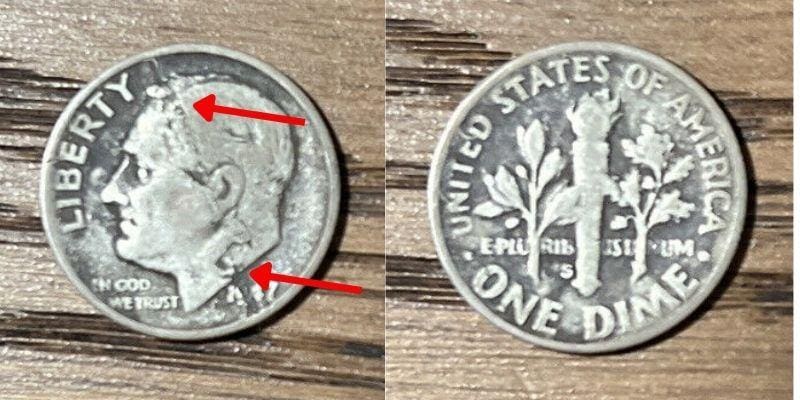
A die break is a type of die defect. These are unintentional flaws on the coin die after excessive use or polishing. Coins punched on a defective die result in an error coin that slips into circulation and can sell with added value. For those with die break, you’ll notice a line of raised metal on a finished coin.
Less obvious die break errors are usual in dimes, making it sell for only $5 to $20. But if the crack is prominent, you can expect it to fetch more or less $100.
1947 Dime Cracked Planchet Error
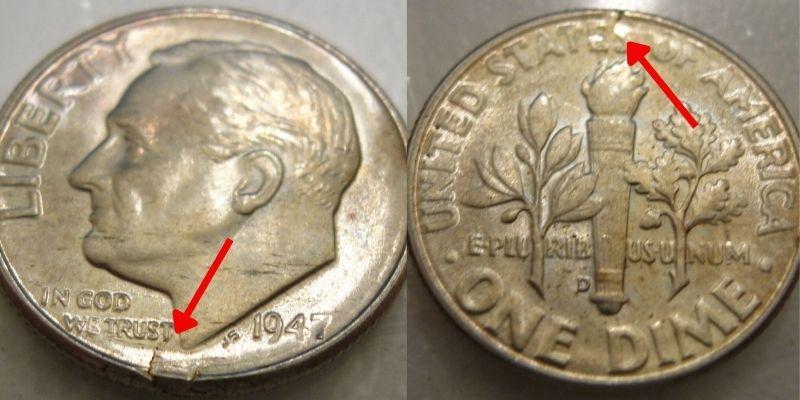
There are a few reasons why a cracked planchet could occur in a coin. The first possible cause is the impurities get mixed with the alloy, causing weakness in the planchet. The other probable way is when the alloy is poorly mixed or if there is a lack of annealing.
Crack that occurs before the minting usually shows anomalies on the edges, while those that happen during or after can result in a broken coin. Coins with this error can sell for $8 to $25, depending on the condition.
1947 Dime Struck Off-Center Error
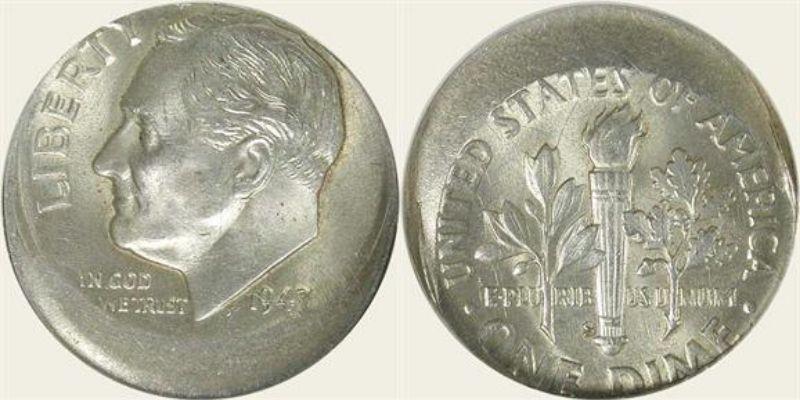
A struck-off-center coin features an offset image on the obverse and reverse sides. It happens when a coin is improperly seated in the coining chamber and is struck off-center. Dimes with this error can fetch $10 to $20 per piece. But those with a complete mint year, a 40% to 60% off-center, and Mint state condition can sell for hundreds of dollars.
Frequently Asked Questions
Is the 1947 dime worth anything?
The 1947 dime is made of 90% silver, making it sell for a higher value than the modern dimes. However, it is more valuable when in coin form than melted. A Roosevelt dime melt value is $1.65, while coins can sell for a few cents higher, starting at $2.10.
Is the 1947 Roosevelt dime rare?
Despite it going in circulation for more than half a century, there is still a good amount of 1947 dime seen in auctions and online selling platforms. Most are also affordable even when in Mint state condition. But again, expect those with Full Torch designation in superb gem condition a challenge to obtain.
What dates in the Roosevelt dime series have silver metal composition?
There are two types of Roosevelt dime. Type 1 is composed of 90% silver and 10% copper, which ran from 1946 until 1964. However, due to the coin and silver shortage in the past, the legislation approved transitioning to clad dimes. From 1965 to date, the metal composition includes 75% copper and 25% nickel over pure copper.

Jenson is a professional numismatist, a dedicated coin collector, a graduate of the College of Business at Oregon State, a life member of the American Numismatic Association (ANA), and an overall coin nerd. He is the founder of Coin Value List.
